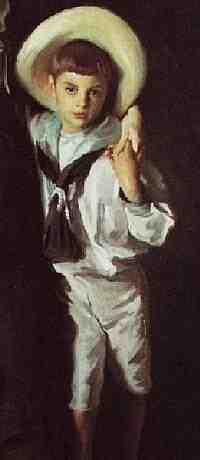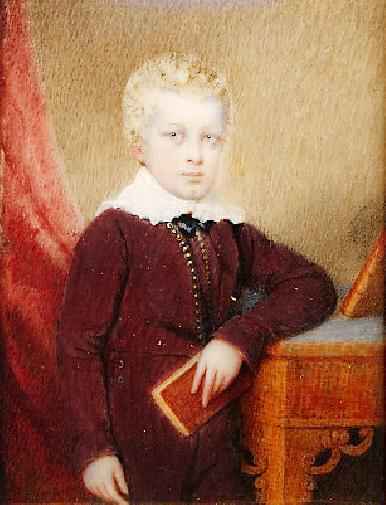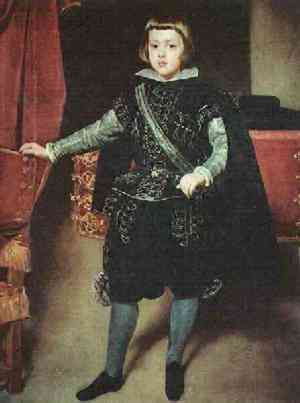
Artists (S-Z) Illustrating Boys' Fashions

Figure 1.--This 1890 painting by John Singer Sargent was one of the artist's many masterful portraits. The boy is American Livingston Davis who wears a white summer sailor suit with kneepants and short socks with a wide-brimmed hat, a classic late-19th Centuruy outfit.
|
|
Art works before the inventionof photography was a major sourxe of information on fashion. Some of the most important artists providing information on boys' fashions in different countries include:
S
Sargent, John Singer (United States, 1856-1925): Sargent is known for his dazling and often daring portraits portraits of British and American high society at the turn of the century. Most of his best
known works are glamorous portraits of eminent or socially prominent people of the period and helped to shape our
view of the era. Sargent was born in Florence, Italy, of American parents. He never attended school as
a boy and did not receive a formal basic education. He spent most of his adult life in England, maintaining a studio there for more than 30 years and visiting America only on short trips. Unlike some other expatriats, however, he always regarded himself as an American. He achieved a great reputation for his portraits. At first he was considered to modern and to French in both England and America, but he was especially sought after by the rich and famous. He is now widely regarded as the leading portrait painter of his generatin. He showed remarkable technical precocity as a painter. Sargent was often criticized for what some believed to be a superficial brilliance and his portraits were largely dismissed after his death. In more recent years, however, Sergent's works have been acclaimed for their naturalism and masterly technical skill. Sargent's work, unfortunately, includes few portraits of boys. Thus while there are many portraits illustrating the dress of women, girls, and men, there are only a few of boys to illustrate fashions in the late 19th and early 20 th Century. The two most interesting are Livingston Davis in a white sailor suit (1890) and Carl Meyer in a grey velvet jacket and ruffled collar (18??). For those of us who beauty in art, Sargents legacy ar e paintings of daziling technical skill, often showing radiently beautiful images of the Gilded Age.
Sayan Polo, Fernando (Peru, 1947- ): This contemprary Peruvian artist has painted an image of a native American boy in his Andean village wearing traditional clothing. Such scenes are no longer common as American clothing has today penetrated even the most remote corners of Latin America.
Schith-Jensen, J. Niels Frederik (Denmark?, 1885-1941): I know nothing about this painter. He is apparently Danish. One source gives his dates as 1885-1941. Ither than this I have been unable to find any information about him. HBC has found one painting he executed that does look rather like a Danish boy.
Schloesser, Carl (Germany, 1832-1914): One of his most famous paintings is Forbidden Fruit," which pictures schoolboys smoking.
Seligmann, Georg (Denmark, 1866-1924): I know nothing about this Danish painter other than he executed some wonderfully detailed portarits with
fascinating depictions of late 19th and early 20th century clothing.
Smith, Edwin Dalton. (England, 1800-52): Edwin Dalton Smith was an accomplished pre-Victorian portratist specialising in portrait miniatures. He was taught by his father, Anker Smith (1759-1819), who was himself a noted engraver and miniaturist. Smith has left us some cahrming early 19th century portraits showing boys' clothing--although the small size does not provide the detail available in the work of other artists. Edwin’s skill in small-scale work is clearly shown in the extensive botanical work that he also did.

Figure 2.--We note a fine watercolor on ivory of a young boy leaning on a desk and holding a book. Note the lace collar and use of buttons. This minaiture was reportedly attributed by Sotheby's, London to Jeremiah Steele, an English artist working in the first third of the 19th century.
|
|
Steele, Jeremiah (England, early 19th century): We note a fine watercolor on ivory of a young boy leaning on a desk and holding a book (figure 2). Note the lace collar and use of buttons. This minaiture was attributed by Sotheby's, London to Jeremiah Steele, an English
artist working in the first third of the 19th century. It is undated, but was probably painted about 1820.
Steinberg, Vasily (Russia, early 19th century): We have been able to find no information about Vasily Steinberg other than he was a Russian painter in the early 19th century. The name suggests German Jewish origins. He appears to have painted genre scences, incliding one 1839 portrait of a serf sheaperd boy in southern Russia.
Stock, J.W. (United States, 1815-55): This American primitive artist painted many New England portraits, providing much valuable information on individual fashion in the era before children's fashions were extensilvely covered. This was was especially important in the a period before photography began to
provide detailed images.
Sully, Thomas (England/United States, 1783-1872): Thomas Sully is one of the most impoprtant American portratists. He painted individuals as diverse as Lafayette, President Andrew Jackson and a very young Queen Vuctoria. He is particularly noted for his full-lenghth portraits and sensitive depictions of women. He also painted many portraits with theatrical themes. We only know of one portrait of a boy at this time, but surely there must be more among his many portraits.
T
Tayler, W. Easton (England, early 20th century): E. Easton Tayler was a London-based portrait painter. He exhibited at the Royal Academy. W know very little about the artist. One portrait painted in 1928 shows a curly haired English boy in a pink play suit.
Tissot, James Jacques Joseph (France/England, 1836-1902): This French painter fled France after the French Commune in 1871 and lived and worked in England where he was widly popular. Modern critics consider his work insipid and sugary. Sugary it is, but it is also technically skilled and provides us marvelosly detailed windows into the life of the Victorian family--however idealized. His images provide fascinating glimes on the children appearing in all the static studio shots of the late 19th Century.
Titian (Italy, c. 1485-1576): Titian (Tiziano Vecelliois) is of course one of the great masters, the greatest painter of the Venetian school. Titian's influence on later artists has been profound: he was supreme in virtualy every aspect of painting and fundamentally changed painting with oils technique with his free and expressive brushwork. He worked on a wide range of subjects, but it his wonderfully expressive portraits that offer important information to HBC.
Tuke, Henry Scott (England, 1858-1929): The distinguished English painter Henry Scott Tuke devoted almost his entire career to painting boys and young men. We were not sure wheter to include him on the HBC list, however, as he generall painted them nude or semi-nude without much attention to clothing. Thus his work is of less interest to HBC than other painters we have listed who often painted only a few boys. We finally decided to include him when a reader submitted this entry because as HBC has evolved over time we have gradually devoped into a wider concern with childhood than an exclusive concern with clothing. Tuke's favorite subject was nude boys in seaside locations (usually Cornwall), but he did paint some images of boys who are partially clothed. There is nothing prurient or pornographic in his work.
U
V
Van Dyck, Antoon (Belgium, 1599-1641): Antoon
Van Dyck was born during 1599 in Antwerp,
which was at the time then the main port of the Spanish Netherlands,
basically modern Belgium. He was to become one of the most succesful
portrait painters of the day and awarded a kighthood by England's
Charles I. His brilliant portraits of the Cavalier nobility, resplendent in satin and lace stand to day as our major window into the world of Stuart England. These paintings were also to inspire the elaborate Little Lord Fauntleroy suits of the late 19th Century. Interestingly, Van Dyck's grandfather had made the family fortune by selling luxurious fabrics, velvet, satin, and lace.
Van Oost the Elder, Jacob (Flanders-Belgium, 1601-71): Relatively little information is available on the life of Flemish master Jacob van Oost. He became a master in the Bruges guild of St. Luke in 1621. Three decades later he was appointed the official painter of the city of Bruges in 1651. Burges was at the center of the Flemish economic expansion in the 17th century. Van Oost held this position until he died in 1671. A few of his paintings show fascinating images of the way children were dressed in the rich city of Byrges.

Figure 3.--This portrait of Don Baltazar Carlos was painted by
Spanish master Velazquez about 1635.
|
|
Velazquez, Diego Rodriguez de Silva (Spain, 1599-1660): Velaquez
is generally recognized as the chief painters of the Spanish school and one of the
great masters of all time. He was born in Seville and a self-taught
painter. He first visited Madrid, the royal capital, in 1622. He made
his name there with one of his street scenes, the Water seller. King Philip IV commissioned him to paint his portrait. Velazquez was appointed pintor en camara, with a lucrative stipend. He furthur improved his acclaim at court with a work appealing to Spanish nationalism, Expulsion of the Moriscos and was appointed usher of the chamber. He traveled in Italy to learn about the art of the great masters. He returned to Italy in 1648-50 with a commission from the king to buy art. Many of his paintings are portraits of the royal family and Spanish nobels. Many were painted as children giving an excellent view of how aristocratic Spanish children were dressed in the 17th Century--esentially in scaled-down versions of how their parents were dressed.
Venetsianov, Alexey (Russia 1780-1847): Alexey Venetsianov was active in the early 19th century. He painted some wonderful images of early 19th century Russian life. Some of the paintings depict upper-class life. His best remembered paintings, however, are his masterfull images of Russiam peasant life in the years just before the abolotion ofserfdom. Some of the paintings include Russian serf boys.
Vigee le Brun, Elizabeth (France, 1755-1842): Elisabeth Vigee le Brun was notable for the images she painted of the French royal family, especially Marie Antoinettee and her children. The best portraits of the royal children were done by le Brun. After the Revolution she went into exile, living in Italy and Austria and finally Russia where she was protected by the Emperess Catherine II. She wrote a fascinatin memoir which is available online.
Vuillard, Édouard (France, 1868-1940): Édouard Vuillard had a long professional career. His work covered the fin-de-siècle of the 19th century and the first 4 decades of the 20th century. Hecwas a prolific artist, completing over 230 works. He has been described as a "quintessentially Parisian artist". His earlist rather formal academic studues gave way to the innovative Nabis paintings done during the the 1890s. These are the paintings for which he is best known and deal primarily with the avant-garde theatre. Less well known are his light-filled landscapes and several elegant portraits done late in life. We note his paintings uin parks and other outdoor scenxes giving charming view of Parisain life. Children often figure un thesescenes.
W
Watts, Frederick W. (England, 1817-1904): George Frederick Watts was a major English artist during the Victorian era. Watts knew most of the Pre-Raphaelites, and was an important influence on the younger ones. He can not be easily clasified as part of any School or group. He struck on his own and is especially known for main allegorical pictures of consideranle note. He also painted many portraits providing us a few glimpses of clothing styles incliding boys' clothing.
West, Benjamin (English America/England, 1815-55): This American primitive artist painted many New England portraits, providing much valuable information on individual fashion in the era before children's fashions were extensilvely covered. This was was especially important in the a period before photography began to
provide detailed images.
Wildman, John R. (England, early 19th century): HBC at this time has virtually no information on English portratist John. R. Wildman. We do know that he was active during 1823-39. We know of one charming portarit of children showing a boy wearing a skeleton suit, but are unfamiliar with his complete body of work.
Williams, Ralph William (United States, 1958): Ralph William Williams was a well-known American commercial artist. He is best known for his "Breck Girls" art which was so popular in the 1940-60's. The ads were for Breck shampoo. Many magazines carried the ads which were done in his photo-realism style. We have one portrait he did of a boy in 1958. There is lots of info on the internet about this artist, including locations of museum exhibits. The subject tells us that his parents were thrilled to have the artist with his distinctive style do a portrait of their son.
Winterhalter, Franz Xaver (Germany, 1806-73): Winterhalter was one of the most important Victorian portrait painters. While German, he painted the crown heads of Europe. He was Victoria's favorite portrait painter. He painted two of the most famous portrits used by HBC. One of course is the young Edward VII wearing a white sailor suit--few paintings had more impact on boys' fashions. The other famous Winterhalter painting used by HBC is of the young royal family.
Wright, Joseph (England, 1734-97): Joseph Wright is sometimes referred to as Wright of Derby. He was an innovative painter who is noted for the artistic treatment of industrial subjects. He lived and workjed in Derby which was at the center of England's industial develoment. He is also known as particularly gifted in his ability to depict artificial light. He did several portraits, including some of children.
X
Y
Yeames, William Frederick (England, 1835-1918): W.F. Yeames was the son of a wealthy British diplomat. william displayed artistic talents at quite a youthful age. His parents encouraged his interest in art as a young boy. The family began an extended toured Italy in 1841 when William was 6 years old, in part to expose him to the work of the Italian masters. While still in Italy, William's father died in 1842. The family then went to live in Dresden. William was tutored at hom with special attention given to artistic studies. William in while only 13 years old moved to London. There he studied under a noted sculptor, Westmacott, as well as George Scharf. After his studies in London, William again traved in Italy. Hi first exhibit at the Royal Academy after is return to England during 1854. His traditional style and heroic historical subjects made him very popular with the English establishment. He became ARA in 1866 and was elected RA in 1878, and finally Librarian at the Academy. He held many other offices such as Curator of the Painted Hall at
Greenwich. One of his more notable paintings was a Civil War scene, "Where did you last see your father?"
Z
HBC

Navigate the Boys' Historical Clothing Web Artist pages:
[Return to the Main individual artist alphabetical page]
[Artist A-F]
[Artist G-L]
[Artist M-R]
[]
Navigate the Boys' Historical Clothing Web Site:
[Return to the Main art page]
[Introduction]
[Activities]
[Biographies]
[Chronology]
[Clothing styles]
[Countries]
[Bibliographies]
[Contributions]
[FAQs]
[Glossaries]
[Images]
[Links]
[Registration]
[Tools]
[Boys' Clothing Home]
Created: February 29, 1999
Last updated: 9:15 AM 8/17/2006


